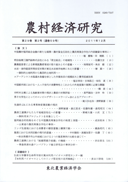Volume 33, Issue 2
Displaying 1-21 of 21 articles from this issue
- |<
- <
- 1
- >
- >|
Cover
-
2015 Volume 33 Issue 2 Pages 0
Published: December 01, 2015
Released on J-STAGE: September 04, 2019
Download PDF (99K)
Special Issue on 50th Anniversary Meeting: Discussion on future issues of agricultural economics research in TOHOKU region
-
2015 Volume 33 Issue 2 Pages 1-2
Published: December 01, 2015
Released on J-STAGE: September 04, 2019
Download PDF (203K) -
2015 Volume 33 Issue 2 Pages 3-10
Published: December 01, 2015
Released on J-STAGE: September 04, 2019
Download PDF (1630K)
Session 1: Rural people and works rooted in the communities and climate of TOHOKU region
-
Article type: research-article
2015 Volume 33 Issue 2 Pages 13-23
Published: December 01, 2015
Released on J-STAGE: September 04, 2019
Download PDF (1758K) -
Article type: research-article
2015 Volume 33 Issue 2 Pages 24-34
Published: December 01, 2015
Released on J-STAGE: September 04, 2019
Download PDF (1724K) -
2015 Volume 33 Issue 2 Pages 35-36
Published: December 01, 2015
Released on J-STAGE: September 04, 2019
Download PDF (272K) -
2015 Volume 33 Issue 2 Pages 37-38
Published: December 01, 2015
Released on J-STAGE: September 04, 2019
Download PDF (310K)
Session 2: The Frontier of farming: High added value and resource utilization
-
2015 Volume 33 Issue 2 Pages 39-46
Published: December 01, 2015
Released on J-STAGE: September 04, 2019
Download PDF (1736K) -
Article type: research-article
2015 Volume 33 Issue 2 Pages 47-56
Published: December 01, 2015
Released on J-STAGE: September 04, 2019
Download PDF (2381K) -
2015 Volume 33 Issue 2 Pages 57
Published: December 01, 2015
Released on J-STAGE: September 04, 2019
Download PDF (141K) -
2015 Volume 33 Issue 2 Pages 58-59
Published: December 01, 2015
Released on J-STAGE: September 04, 2019
Download PDF (352K)
Session 3: Current situation and future issues of agricultural structure in TOHOKU region
-
Article type: research-article
2015 Volume 33 Issue 2 Pages 60-69
Published: December 01, 2015
Released on J-STAGE: September 04, 2019
Download PDF (2982K) -
2015 Volume 33 Issue 2 Pages 70-79
Published: December 01, 2015
Released on J-STAGE: September 04, 2019
Download PDF (1431K) -
2015 Volume 33 Issue 2 Pages 80-81
Published: December 01, 2015
Released on J-STAGE: September 04, 2019
Download PDF (364K) -
2015 Volume 33 Issue 2 Pages 82-83
Published: December 01, 2015
Released on J-STAGE: September 04, 2019
Download PDF (302K)
Session 4: Task and vision of the support system for agriculture: Agricultural cooperative and extension work
-
Article type: research-article
2015 Volume 33 Issue 2 Pages 84-93
Published: December 01, 2015
Released on J-STAGE: September 04, 2019
Download PDF (1991K) -
Article type: research-article
2015 Volume 33 Issue 2 Pages 94-104
Published: December 01, 2015
Released on J-STAGE: September 04, 2019
Download PDF (1662K) -
2015 Volume 33 Issue 2 Pages 105-106
Published: December 01, 2015
Released on J-STAGE: September 04, 2019
Download PDF (286K) -
2015 Volume 33 Issue 2 Pages 107-108
Published: December 01, 2015
Released on J-STAGE: September 04, 2019
Download PDF (235K) -
2015 Volume 33 Issue 2 Pages 109-115
Published: December 01, 2015
Released on J-STAGE: September 04, 2019
Download PDF (981K)
Back cover
-
2015 Volume 33 Issue 2 Pages 116-118
Published: December 01, 2015
Released on J-STAGE: September 04, 2019
Download PDF (291K)
- |<
- <
- 1
- >
- >|
